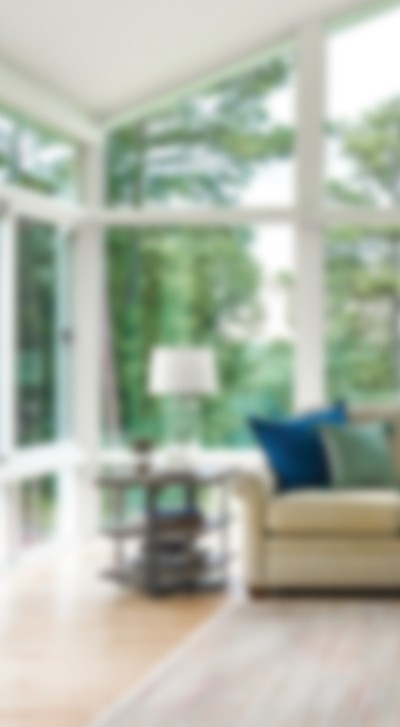


Expert Overview
- Screened-in porches and three-season sunrooms each offer shelter from the sun and protection from bugs.
- Screened-in porches offer very little protection from wind and rain, since they don’t have windows that close (as three-season sunrooms do).
- Three-season sunrooms lack insulation and double paned glass, but they are very usable three seasons out of the year.
If you’re seeking an outside space for spending time in the fresh air with your family and friends, a screened-in porch or a three-season sunroom each offer excellent value. Both room additions are relatively easy and inexpensive to construct, and both provide a sheltered area for relaxation, peace and fun.
So how can you decide between the two? Let’s dig in to learn a bit more about each type of space.
What’s a screened-in porch?
A screened-in porch is a standard covered porch with screen windows on three sides for ventilation. These screens are often floor-to-ceiling.
Screened-in porches are primarily outdoor spaces, but they provide shelter from direct sun and protect people and food from insects. They are perfect for outdoor dining in the summer or for curling up with a blanket on a mild spring or fall day. Parents often find that a screened-in porch is an excellent place to send their children to play outside during a spring rainstorm.
Screened-in porches don’t require insulation, so you can install one quickly and economically. Screening in an existing porch or constructing a screened-in porch from the ground up is a more economical choice. From the outside, porch enclosures can have the same type of exterior siding and roof paneling as the rest of the home. However, screened porches often look separate from the rest of the house, because screened windows are darker than standard windows, and often much longer.
Screened-in porch ideas
There are so many great ideas for how to use a screened-in porch. You can make it comfortable by furnishing it with indoor/outdoor furnishings and bringing your personal style to decorating it. You can protect the furniture on your screened-in porch by covering the screens with exterior shades that you can roll up and down as needed. But remember, these shades offer limited protection. They don’t regulate the temperature inside the porch. Instead, they shield the porch interior from rain and wind.
Screened-in porches are not standard living spaces, since they’re not fully sheltered. This means you’ll use a screened-in porch most in late spring, summer and early fall. But during those times, you can find dozens of ways to enjoy your screened-in space, from birthday parties and barbecues to morning coffee or yoga.
How screened-in porches and three-season sunrooms differ
Screened-in porches are outdoor rooms, and as such, are almost completely exposed to rain, wind and cold temperatures. You’ll be somewhat limited in the type of furniture and other possessions that you can keep in these spaces, because indoor-grade furniture can become moldy or rotten when regularly exposed to the elements.
Three-season sunrooms are similar to finished rooms. They have little or no insulation, but are still somewhat protected from outside temperatures and can be heated with space heaters during colder months. Typically, they are used from spring through fall. During rain and wind storms, you can close the windows in a three-season sunroom to protect the space. They also look more like a standard room, with walls beneath the windows, and windows that do not extend all the way up to the ceiling.
Three-season sunrooms are also more expensive than screened-in porches. You can control costs by shopping around for the right contractor, choosing the right building materials and limiting the size of the sunroom. However, for homeowners on a budget, a screened-in porch is a more affordable option.
Let’s do a quick side-by-side comparison:
Screened-in porch characteristics
- Offers little protection from wind and rain
- Offers no protection from extreme cold or heat
- Provides protection from insects
- Good place to spend time when temperatures outside are comfortable
- Lower in price
Three-season sunroom characteristics
- Offers protection from wind and rain
- Provides limited protection from extreme temperatures
- Provides protection from insects
- Good place to spend time for three seasons out of the year
- More costly to install than a screened-in porch
How do the materials differ in each structure?
Three-season sunrooms have windows with single pane or insulated glass, and screens, so that the windows can be opened. Usually a three-season sunroom consists of siding and a matching roof panel on the outside, and normal indoor flooring and drywall on the inside. The structure is made from aluminum, or sometimes wood.
This is different from a screened-in porch in that a screened-in porch often has a concrete floor, and the structure is made of wood. Metal screens are attached to the framework to keep out the bugs.
When trying to decide between the two structures, think about your budget and how you want to use the space. A homeowner seeking additional outdoor living space in their house for three seasons out of the year will be happier with a three-season sunroom. However, for homeowners seeking an inexpensive sheltered area where they can be protected from insects and direct sunlight, a screened-in porch may be enough.

